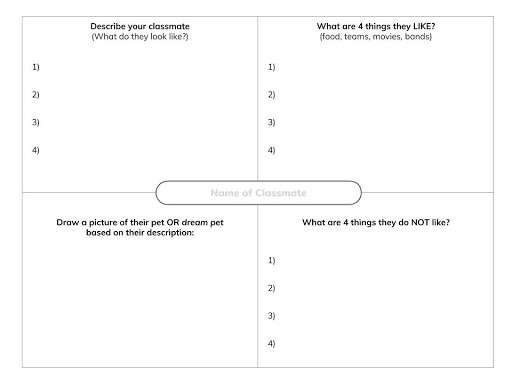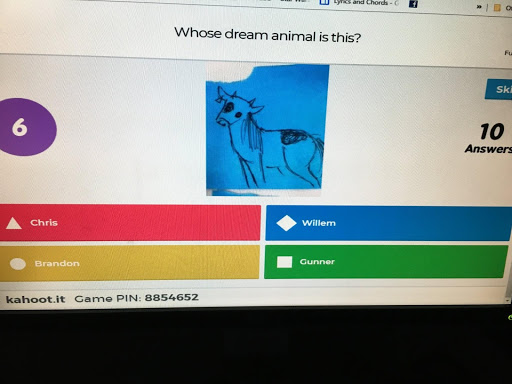I am always looking for new ways students can enjoy learning and connect with their classmates. Combining Kahoot! with other learning models in my English class made a big difference!
As I mentioned in my previous article, I got a lot of inspiration from a book I recently read – The EduProtocol Field Guide: 16 Student-Centered Lesson Frames for Infinite Learning Possibilities. Marlena Hebern and Jon Corippo talk about customizable student-centered learning frames that use your content to create lessons that help students master academic content. One of the presented lesson frames was “Frayer a Friend”, a fun way to introduce the Frayer model and have students use it in different ways, such as getting to know their friends.
(If you’re not familiar with the Frayer model, let me start with a quick recap. It’s a graphic organizer for building student vocabulary. Students define key vocabulary and practice it by putting the following info into a chart with four sections: definition, characteristics, examples, non-examples and maybe even picture to explain meaning of certain words. Here’s an example 🙂
Fun from the start with Frayer a Friend
EduProtocols allow you to start with something fun to teach the frame, system, and protocol of the lesson, so students can learn the system before being asked to master the system and the content simultaneously.
Enter, Frayer a Friend. This frame has a handout setup like the Frayer Model, but instead of using it with vocabulary right away, it capitalizes on a more fun subject (as a Get to Know You tool) while giving students practice in using proper protocol.
Each of the four quadrants has specific questions to ask a classmate and room for students to record the information. Students put the name of the person being interviewed into the center circle and periodically must share information about the person they interviewed as they do it, which the teacher can customize into their lesson.

Trying something new
I didn’t delay testing out this new activity, and we tried it on the third day of school. To save paper, I had students write down the information from the four students onto just one handout. It took a bit of explaining, but we got the hang of it.
I gave each student 4 sticky notes for the drawing the dream pet section and I played fun music chosen by students. This was fun! That evening, I thought about how to use the information. I observed every student on task, talking and giggling with their peers, and seemingly enjoying themselves. And then it hit me….
Kahoot! + Frayer Model = fun new learning!
A simple and fun way to integrate tech into this activity would be to combine it with Kahoot! What if each student took their completed interview paper and sticky notes and used the information to create a 20-question kahoot about the classmates they interviewed?
They would include pictures of the dream pets they drew, so other students and I helped those who needed it with this step by taking the pictures ourselves, and then we emailed those pictures to the students who uploaded them into a kahoot. The rest of the students used their smartphones.
Putting it all together
I created a Google Classroom assignment and the students added their kahoots to them. Students’ grades were based on having the desired number of questions, the pictures they drew, and proper English and grammar (I am an English teacher, after all).
Surprise after surprise
During this activity, we might learn that Marshall’s favorite dream pet is a frog/chicken/bull (AKA the ‘Fricken Bull’) and that Hayden can draw it really well! Maybe Clay loves watching the Food Network on his phone, or that Charlie loves to spend his weekends learning to fly planes with the Civil Air Patrol in our area (who knew?). We discovered that AJ likes to spend time with his girlfriend (wait, we knew that.)

Fun, learning and friendly competition
The activity taught my students how to ask good questions and boosted their interviewing skills. Of course, they also enjoyed learning about their peers. The student who created the kahoot had the option of playing it or not. If they did play it, and finished 1st (seems logical but doesn’t always happen), then I gave the 1st place gum to the 2nd place winner. Best friends really like this, and students try to finish ahead of best friends, which then amplifies the fun for all!
Students enjoy getting to know each other with Kahoot! and learn the value of asking good, creative questions. Build communities within your classroom: add Kahoot!, a dash of synthesizing information, a pinch of critical thinking, a teaspoon of fun, and now your classes look different. Feel different. That’s powerful. That’s fun.
________________________________________________________________________
Have some classroom tips to share with other Kahoot!’ers? Tweet us @GetKahoot to tell us about it and become a guest author on our blog!




